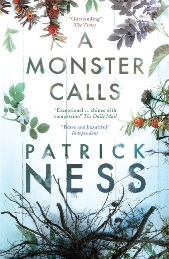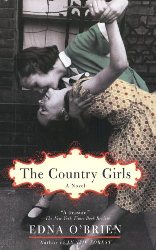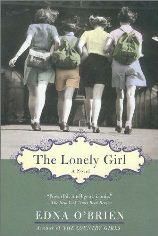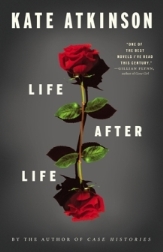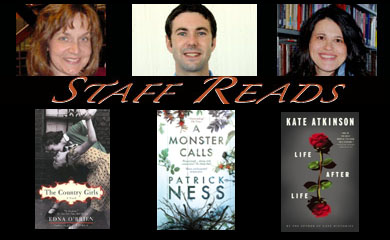
Are you looking for a good book to read? Hundreds of thousands of books are published each year, so how does one choose? Read on for several Milne Library staff book recommendations for the month of October.
In the mood for a spectacular YA fantasy? Then read the following recommendation by Bill Jones, IDS Project Creative Technologist, for a truly amazing young adult novel:
The multiple award-winning YA novel, A Monster Calls by Patrick Ness, is a story filled with surreal illustrations and a captivating
storyline that leaves the reader wondering what is in fact real and what is simply perceived to be. The story is told through the eyes of a teenage boy named Conor, who describes his struggle in coming to terms with his mother’s cancer and the terrifying possibility of losing her. Awakened from a nightmare, a monster comes to help Conor understand his future and admit truths that he holds deep inside.
Throughout the novel, the monster shares with Conor three stories to help him understand the truths of life and what lies ahead. “The answer is that it does not matter what you think,” the monster said. “Because your mind will contradict itself a hundred times each day. You wanted her to go at the same time you were desperate for me to save her. Your mind will believe comforting lies while also knowing the painful truths that make those lies necessary. And your mind will punish you for believing both.”
Check out Patrick Ness’ amazing three-part Chaos Walking Trilogy: The Knife of Never Letting Go (2008), The Ask and the Answer (2010), and Monsters of Men (2010).
Download the free prequel of the trilogy, A New World, today from Amazon Kindle!
Special Collections Librarian Liz Argentieri recommends an Irish writer and a trilogy which broke numerous social and literary barriers when first released in the 1960s.
Edna O’Brien’s Country Girls trilogy includes The Country Girls (1960), The Lonely Girl (1962), Girls in Their Married Bliss (1964). All three novels were then reissued together with an Epilogue in 1987.
The impetus to pick up Edna O’Brien’s Country Girls trilogy came from chancing upon a panel discussion of it on the Diane Rehm show last spring. Dealing with growing up female and Catholic in mid-20th century Ireland, it sounded intriguing: controversial, daring, and literary. And since I liked what I had read of O’Brien’s short stories, I thought I’d tackle her trilogy. I’m glad I did.
The novels center on Caithleen (“Kate”) Brady, mainly, and her friend Bridget (“Baba”) Brennan, whom we first meet as two young teenage girls living in a small Irish town and straining against the confines of their lives – as teenagers often will. They are an unlikely pair, and I never did grow to like Baba. Throughout, she bullied Kate and quite literally led her astray, beginning with her orchestration of getting them both expelled from convent school (an opportunity Kate, whose mother had recently died and whose drunk of a father drifted in and out of her life (usually violently) could ill-afford to squander). But Kate was not easy to root for either. Watching her drift through her own life, allowing friends, family, and lovers to largely decide her course, often made for frustrating reading, and if it weren’t for her sweetness and vulnerability and the unfortunate events in her life that she truly was unable to control, I might have had less sympathetic feeling for her.
The tone and point of view of the narration shifts between Kate and Baba. When Baba’s telling the story, the language is more lively, the attitude more devil-may-care, but I’m sure I sensed an underlying pathos in there, especially in the last novel and Epilogue, when the two had more or less “made their beds.” A current of loneliness flows through Kate’s rather spare narrative voice, especially when she’s talking or thinking about her girlhood home, a run-down farm on the edge of town. The language she uses to describe that place and her life there – which was not without happiness and love – evokes the stereotypical image of a rainy, damp, bleak Ireland. The feeling carries through her days in Dublin as a shop girl and Baba’s reckless tag-along, her romantic misadventures with older married men, and her ultimate fate.
Are you a fan of contemporary literary fiction? Librarian Kate Pitcher recommends Life After Life, the latest novel by Kate Atkinson:
Ursula Todd is born on a cold and blustery night in 1910, and then dies. She is then reborn, living through her traumatic birth, until a tragic death by drowning. Ursula is then reborn again, lives a happy but chaotic childhood and dies in a firebombing during World War II. She is then reborn again.
Kate Atkinson (author of the wonderful Jackson Brodie mystery novels; Case Histories, One Good Turn, When Will There Be Good News? and Started Early, Took My Dog) is an expert storyteller and a literary artist. In her newest novel, she takes on an interesting device to tell the story of her heroine, Ursula Todd. What if your life didn’t really end at your death, rather, that your life is actually a series of lives as one person, and that you are destined to relive some of the same experiences over and over again, until you get it right? This is the conceit that Atkinson employs to show Ursula’s development as a character and a person living through some of the worst calamities the human race has ever known – two World Wars and the almost entire destruction of people, namely those of the Jewish faith during the Holocaust.
Atkinson’s novel explores Ursula’s surreal sense of déjà vu and it works – the reader plays along and relives these lives; each one slightly different than the one prior, depending on how Ursula “learned” from that life. What captures the reader’s imagination is the authors’ shaping of the narrative; how she uses the same plot and events, but almost every chapter reads like a different story. It is a completely inventive and captivating story and engages the reader from page one, until the end, when we are left with the desire to relive those lives all over again. Highly recommended, especially for fans of literary fiction and authors such as Margaret Atwood and Jennifer Egan.

